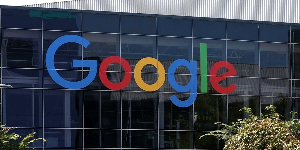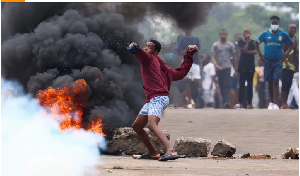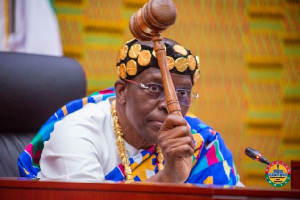The Free Senior High School policy is hinged on three ideologies that also serve as its motto; Access, Quality, and Equality. Whereas it (the policy) has improved access to education tremendously, quality will seem to be its biggest hurdle just a year into implementation while it is yet to broach, the issue of quality.
It will be fair to say per public reaction and media reportage, a lot of Ghanaians have their heads pretty wrapped up on the issue of the Free SHS policy and to a large extent the five year intervention of a double track system that birthed a semester system of 81 days of academic contact days with long holidays.
The challenge for most is the ‘rush’ to push the double track system as the best alternative to an expected increase in enrollment with the second batch of free SHS students. The Ghana Education Service on Tuesday, September 4 announced the school opening date for the first batch (Green track) and second batch (Gold track), 11 September and November 8 respectively.
But are the numbers paraded around as the reason for the double track system true?
Analysis heavily depends on data as provided by the Ministry of Education.
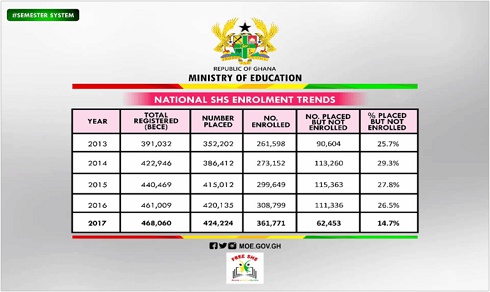
Over the past four years, the number of students who have sat for the BECE has increased at an average of 4 percent with the lowest year of increase experienced in 2017 (2%) and the highest been 2014 when some 8 percent increment over the previous year was recorded.
Projection by MOE, however, was that for the 2018/2019 academic year some 521,710 would seat for the examinations; an 11 percent rise from the previous academic year.
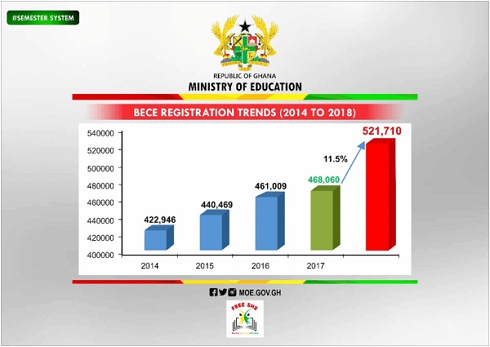
But per the provisional results earlier released by WAEC, the institution puts the figure at some 509,827 pupils registering to partake (an increase of 8 percent according to WAEC).
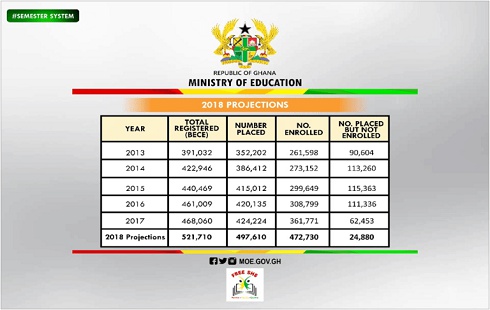
Surprisingly, however, the GES in its media release announcing the number of students placed and yet to be placed repeated the MOE projection of registered students of 521,710. How come the GES and WAEC are having conflicting figures for registered pupils?

According to WAEC of those over 509, 827 candidates 0.93% (4,741) did not turn up for exams, 83 have had their entire results canceled, 134 had some subjects results canceled and some 2,061 results withheld. This means some 7019 pupils are not in contention for SHS education at least for the 2018/2019 academic year. That brings the number of candidates likely to go to SHS to 502,808 (that is if we had a 100 percent pass rate).

According to the MOE projections, some 497,610 pupils, 95 percent of the ministry’s projected 521,710 would get placed.
According to the GES, 490,514 pupils pass the BECE examinations. A 96% pass rate a jump of 6% from previous year’s and a leap of 5% in a five year average (that is if you used WAEC official number of registered students) and some 94% if you used the projected figure of MOE as repeated by the GES in its placement media release.
[Some argue the high pass rate is as a result of the new grading system where grade 8 is a pass mark instead of 6 which was the case in the former grading system. It, therefore, means that a grade 48 [8 (grade) *6 (subjects)] should get placed. Whereas in the former dispensation, a grade 36 (grade 6 in 6 subjects) did not get placement because the cut point that qualified for placement was 24].
But what it actually means then is that, of the 502, 808 students who after marking are eligible for placement, the GES is suggesting that approximately there was a 98%[490,514/502,808 *100] pass rate, thus apart from those who were caught for malpractice and did not turn up for the exams, almost every one pass the 2018 BECE.
PLACED BUT UNENROLLED
The government was able to reduce drastically the national average of unenrolled but placed students, over the past 4 years which was 27 percent non-enrolment, to 15% for the academic year 2017/2018. This remarkable 12 percent is the actual achievement of the free SHS system. Over the past four years, an average of 73 percent of students got enrolled.
Meaning with or without Free SHS, 73 percent of graduates from the Basic level would have gone to school anyways with an average of 27% always not going despite being placed. Thus it could be fair to say 12 percent of the last batch of BECE graduates who may have not made it to SHS did as a result of the new policy; the reason for the drastic drop from 27% to 15% for last academic year.
The president has on a number of occasions referred to 90 thousand more pupils benefitting from the Free SHS policy. The 12% reduction in the national average of placed but not enrolled are those 90 thousand more pupils the president speaks about. (President Akufo-Addo: 90,000 people benefitted from the policy in its first year, NPP Delegates Congress & Ceremony to Welcome Otumfuo to Jubilee House).
However, the challenge is with the other statistics the president puts out about the number of people who will be enjoying Free SHS when the double-track system comes into effect. The president puts that figure at some 180 thousand students.
That figure, unfortunately, cannot be accurate. Based on the number of students who took the 2018 BECE Examination and those who may miss out due to malpractice, (457,558) bearing in mind the national average on enrolment against national average on placed but not enrolled, 180 thousand cannot statistically stand, no matter how you manipulate the figures.
That figure, unfortunately, cannot be accurate based on the number of students who took the 2018 BECE and those who may miss out due to malpractice (502,808 took the exam).
Per the GES pass students data (490, 514), 7, 096 students are not in contention for free SHS as planned for by the Ministry of Education in its projection for the academic year.
Should all these 490,514 pass students go to school, that will be some 128,743 more students enrolled over last year’s figure of 361,771.
But that a national average of placed but not enrolled students has stood at an average of 27 percent only reducing to 15% as at the beginning of free SHS, how then can 180 thousand more students be getting access to free SHS.
Note however per the MOE analysis, they expect to have a 5% rate of placed but not enrolled. That means some 104,217 more students instead of the President’s 180,000 are going to school this year.
The reason for the double track system is the numbers, it is critical to scrutinise the numbers so as to answer the question if free SHS really is the solution and if we need it now.
FACTS TO CARRY ALONG
- Some 60 thousand students have not been placed as at the publication of this article.
- Should the MOE meet its target of only 5% placed but not enrolled figure, then it means some 465,988 [490,514 – (5% of 490,514)] students are those that are to run the double track system.
- Putting these students into two group or tracks means each track will carry 232,994 [465988/2].
- This means 128,776 students who could have been accommodated, since 361,771 students went to school, are to stay home and join track B (Gold Track).
- This means 175,251 instead of the 181,993 seat spaces might be needed (all on the assumption that a 5% placed but not enrolled is achieved).
- 299,649, is the number of students who were enrolled in 2015 and happen to be the last batch to have completed SHS in 2018.
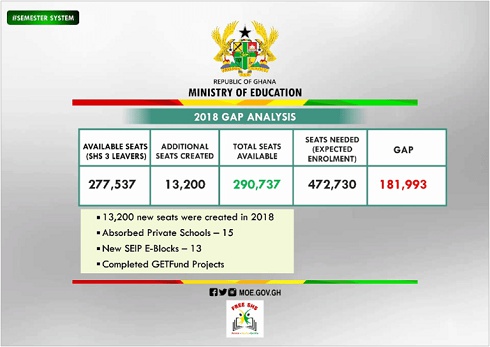
- Per government’s own record, 361,771 were enrolled in 2017. If additional 13,200 seats have been created then the available seats should be 361,771 + 13,200 = 374,971. The question is: why is the MoE using the 277,537 seats created by SHS 3 leavers to arrive at the total seats available, and not the 361,771 seats made available by SHS 1 who are moving on to SHS 2?
- Even if the total space (available seats) of SHS 3 leavers with some 13,200 more seats created leaves seats needed at 472,730. What this means is that some 9 thousand students either dropped out, got repeated or just got missing in the statistics [299,649 pupils got enrolled in 2015. These students are the third year students].
A review of the actual figures prove the numbers are not as presented, and though some more people may have to be accommodated, in the face of all the other options presented to the ministry, the question is, should the new numbers (far less than expected) because for a rethink of the double-track system as the only option out?
NATIONAL SHS ENROLMENT TRENDS
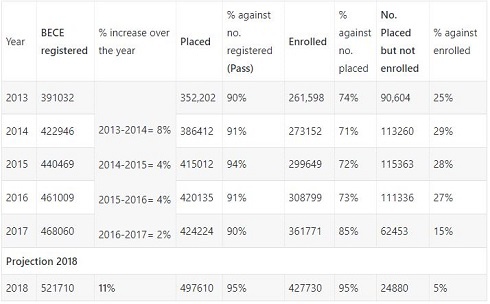
General News of Tuesday, 11 September 2018
Source: 3news.com
MoE, GES ‘cooking up numbers’ to push double-track system?
Business
